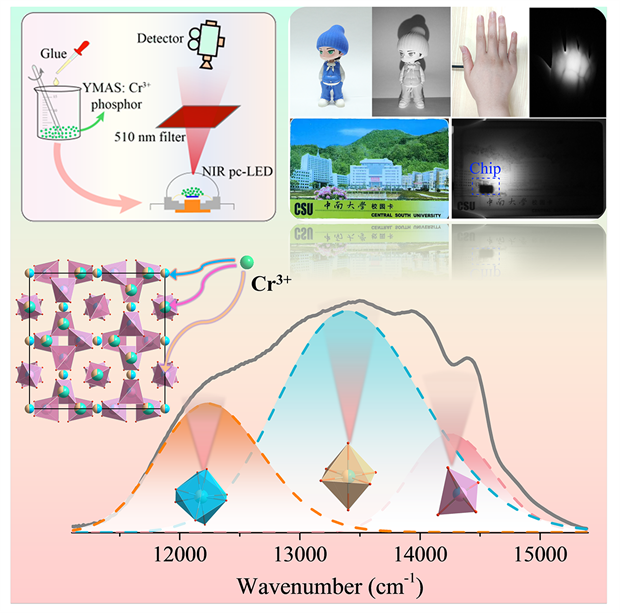Highly efficient and stable NIR phosphor for night vision and bio-imaging
Published 19 April, 2024
Near-infrared (NIR) light source, characterized by non-destructive and rapid detection, has a wide range of applications in diverse fields including food testing, safety, sensing, agricultural production and biomedicine. The availability of a compact, highly efficient and low-cost NIR phosphor is a key factor in achieving its wide application.
NIR pc-LED, boasting qualities such as lower cost and adjustable emission wavelength, has received widespread attention. The key lies in the development of NIR luminescent materials with broadband emission, high luminous efficiency and thermal stability. The tunable luminescent properties of Cr3+ have attracted the attention of researchers. Nevertheless, the diversity in Cr3+ luminescence centers across various hosts poses a challenge. In previous studies, there are different views on whether the near infrared luminescence of Cr3+ comes from 4-ligand or 6-ligand or 8-ligand. Systematic and in-depth research is essential to elucidate the relationship between Cr3+'s occupancy habit and responding photoluminescence properties.
To that end, a team of researchers led by Gemei Cai at the Central South University in China, examined the luminescent properties and crystal field environment of Cr3+ in special matrix Y2Mg2Al2Si2O12 with multiple cationic sites. The NIR pc-LEDs were made from the developed NIR-emitting phosphors, and the potential applications of these NIR light sources in night vision, bio-imaging, and non-intrusive detection were demonstrated.
“With the help of crystallographic investigation, spectroscopy characterization, and crystal-field-strength analyses, Cr1, Cr2, and Cr3 are verified to be originated from Cr3+ in Al/SiO4 tetrahedral, Mg/AlO6 octahedral, and Y/MgO8 dodecahedral sites, respectively,” shares Cai. “Potential applications for this assembled miniaturized NIR pc-LED include night visualization, bio-imaging, and non-intrusive detection, as demonstrated by the clear visualization of blood vessels in a hand as well as chip and circuit layout on a magnetic card under NIR illumination.”
The findings, published in the KeAi journal Advanced Powder Materials, present a Cr3+-activated NIR phosphors with features of outstanding luminescence for multi-functional applications. The study also demonstrates the feasibility of strategy via designing the multi-luminescent centers with intermediate-weak crystal field environment for Cr3+ to achieve broadband emission.

Contact author details:
Ge-Mei Cai, School of Materials Science and Engineering, Central South University, Changsha, P.R. China, caigemei@csu.edu.cn
Funder:
This work was supported by the National Natural Science Foundation of China (No. 51772330), the Fundamental Research Funds for the Central Universities of Central South University (No. 506021713), and the National MCF Energy R&D Program of China (No. 2018YFE0306100).
Conflict of interest:
The authors declare that they have no known competing financial interests or personal relationships that could have appeared to influence the work reported in this paper.
See thearticle:
Li, Gui-Hua, et al. Achieving broadband near-infrared luminescence in Cr3+-activated Y2Mg2Al2Si2O12 phosphors via multi-site occupancy. Advanced Powder Materials, Volume 3, Issue 3, 2024, pages 100186. https://doi.org/10.1016/j.apmate.2024.100186